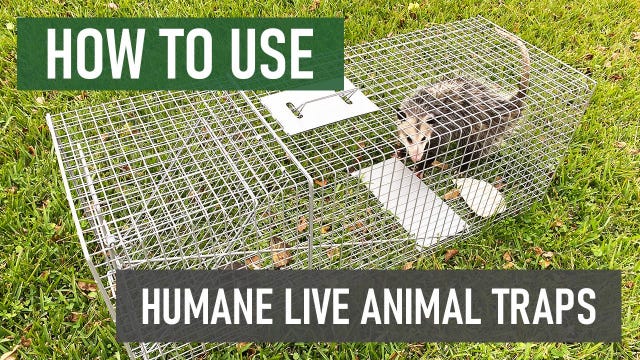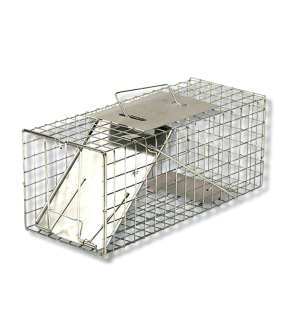Gain access to personalized product screening, the best pricing, rewards, and more!
Most Effective Products
How to Catch a Nutria with a Live Trap
Also known as the coypu, a nutria is a giant rodent. These animals have the potential to destroy your property with their large incisors. This animal is especially a nightmare for property owners near bodies of water. Removing a nutria from your property is using a live trap to catch and release the animal. Live trapping is a safe and effective way to keep animals away from your home.
To catch a nutria with a live trap, read this guide for instructions and product recommendations.
Identification
Before using a live trap, you must ensure that the wild animal you are dealing with is a nutria. This will ensure that you are using the correct bait and strategies.

Nutrias are generally 16 to 24 inches long with a 12 to 18-inch tail. It has dark brown outer fur with gray inner fur. They normally weigh between 8 and 20 pounds. Nutrias have webbed feet and large orange incisors. They are semi-aquatic and spend most of their time in or near water. Their diet mainly consists of vegetation. The nutria eats around 25% of its weight every day.
Use the image and description above to confirm that you are dealing with a nutria on your property.
Inspection
Once you've confirmed that your pest animal is a nutria, it is helpful to recognize the areas where it is most active. This is where you will place your live trap.
Where to Inspect
You want to pick areas that have high activity from nutrias. These animals are most likely searching for food. If your property is near a body of water, you will also want to check this area since nutria will be looking for food.
What to Look For
Nutria are most active between dusk and sunrise, so most damage will be done now. Search for missing plants. When nutria feed on a plant, they eat the entire thing, including the roots. They will also create burrows. Search for disturbed soil, especially near a body of water. Nutria may leave tracks that have 5 toes per foot and webbed hind feet. These tracks can be up to 6 inches long.
Treatment
Now that you've identified your pest animal as a nutria and noted areas where it is most active, you can use your live trap. Be sure to wear gloves when handling the trap to prevent leaving your scent. If a nutria picks up a human scent on the trap, it will avoid it, making it ineffective.
Step 1: Remove Food Sources

You want the nutria to enter the live trap with the help of bait. Because of this, competing food sources need to be removed. Excess vegetation, such as weeds, should be removed, and lawns should be mowed to a reasonable height.
Step 2: Place the Trap
By now, you should have taken note of areas with high nutria activity. These areas are where you will put your trap. Be sure to place your trap on an even surface. A nutria might push or knock over the trap to reach the bait inside. Place a heavy object, such as a brick, on top of the trap to avoid this.
Step 3: Bait and Set the Trap

Using the proper bait will increase your chances of catching a nutria. These animals prefer sweet potatoes, but other foods, such as apples and carrots, will work, too. The bait should be placed near the back of the trap. This ensures that the nutria will need to step on the trigger plate to reach the food.
You will then set your trap by pushing on the door lock and lifting the door plate. Keep the door plate lifted while pulling the trigger arm forward to set it. You will know it is set when the trigger arm's hook catches the door.
Step 4: Monitor the Trap
You will need to check the traps twice a day, preferably once in the morning and once in the evening. This is when you will refill bait if needed. Checking the trap frequently may dissuade nutria from approaching the trap. Do not keep an animal trapped in the cage for 24 hours.
Step 5: Relocate the Nutria

Any non-target animals should be released immediately. Once you have captured a nutria in your live trap, check with your local authorities to ensure you correctly relocate the animal. Approach the trap slowly and use a gentle voice. Place a towel over the cage to avoid frightening the nutria. Once you have relocated far enough, carefully open the trap and release the animal. You can read more about releasing an animal from a live trap here.
Prevention
After using your live trap, you want to ensure that wild animals do not invade your property again. You can take some preventative measures to keep your area nutria-free.
Sanitation
Nutria will not want to visit land that has little vegetation. Remove excess weeds and plants from your property. Brush piles of these excess weeds need to be relocated or destroyed since nutria may use this for shelter. If necessary, you may need to drain your land of excess water.
Exclusion
If your property is near a body of water and you have no fencing, you are more susceptible to having nutria and other wild animals invade your property. Consider blocking off your property with some fencing. If you choose to do this, make sure the fencing is at least 6 inches underground.
Key Takeaways
- Nutria are large aquatic rodents that are most active between dusk and sunrise. They eat vegetation and can cause severe damage to property near a body of water.
- Bait the live trap with sweet potatoes or other food, such as apples, making sure it is placed behind the trigger plate of the trap.
- Check the trap once in the morning and once in the evening. Once a nutria is caught, check with your local authorities to ensure you safely and correctly release it.
- Prevent nutria from entering your property again by removing excess vegetation and disposing of brush piles. If necessary, you may need to drain water from your land.







